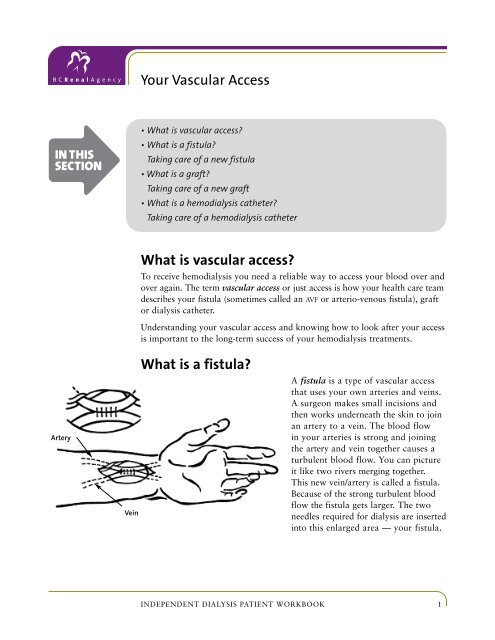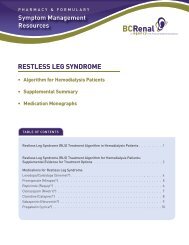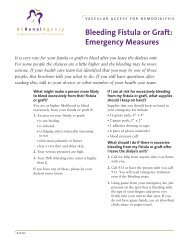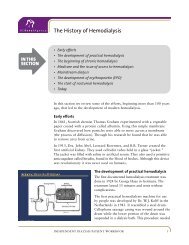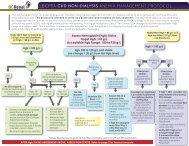What is vascular access? What is a fistula? Your ... - BC Renal Agency
What is vascular access? What is a fistula? Your ... - BC Renal Agency
What is vascular access? What is a fistula? Your ... - BC Renal Agency
Create successful ePaper yourself
Turn your PDF publications into a flip-book with our unique Google optimized e-Paper software.
<strong>Your</strong> Vascular Access<br />
• <strong>What</strong> <strong>is</strong> <strong>vascular</strong> <strong>access</strong>?<br />
• <strong>What</strong> <strong>is</strong> a f<strong>is</strong>tula?<br />
Taking care of a new f<strong>is</strong>tula<br />
• <strong>What</strong> <strong>is</strong> a graft?<br />
Taking care of a new graft<br />
• <strong>What</strong> <strong>is</strong> a hemodialys<strong>is</strong> catheter?<br />
Taking care of a hemodialys<strong>is</strong> catheter<br />
<strong>What</strong> <strong>is</strong> <strong>vascular</strong> <strong>access</strong>?<br />
To receive hemodialys<strong>is</strong> you need a reliable way to <strong>access</strong> your blood over and<br />
over again. The term <strong>vascular</strong> <strong>access</strong> or just <strong>access</strong> <strong>is</strong> how your health care team<br />
describes your f<strong>is</strong>tula (sometimes called an AVF or arterio-venous f<strong>is</strong>tula), graft<br />
or dialys<strong>is</strong> catheter.<br />
Understanding your <strong>vascular</strong> <strong>access</strong> and knowing how to look after your <strong>access</strong><br />
<strong>is</strong> important to the long-term success of your hemodialys<strong>is</strong> treatments.<br />
Artery<br />
Vein<br />
<strong>What</strong> <strong>is</strong> a f<strong>is</strong>tula?<br />
A f<strong>is</strong>tula <strong>is</strong> a type of <strong>vascular</strong> <strong>access</strong><br />
that uses your own arteries and veins.<br />
A surgeon makes small inc<strong>is</strong>ions and<br />
then works underneath the skin to join<br />
an artery to a vein. The blood flow<br />
in your arteries <strong>is</strong> strong and joining<br />
the artery and vein together causes a<br />
turbulent blood flow. You can picture<br />
it like two rivers merging together.<br />
Th<strong>is</strong> new vein/artery <strong>is</strong> called a f<strong>is</strong>tula.<br />
Because of the strong turbulent blood<br />
flow the f<strong>is</strong>tula gets larger. The two<br />
needles required for dialys<strong>is</strong> are inserted<br />
into th<strong>is</strong> enlarged area — your f<strong>is</strong>tula.<br />
INDEPENDENT DIALYSIS PATIENT WORKBOOK 1
<strong>Your</strong> Vascular Access<br />
<strong>What</strong> can I expect from my surgery?<br />
In many situations the surgery required for creating a f<strong>is</strong>tula <strong>is</strong> done as a day<br />
procedure. Th<strong>is</strong> means you don’t spend a night in the hospital.<br />
Usually the surgeon will create the f<strong>is</strong>tula in the forearm of your non-dominant<br />
arm. Th<strong>is</strong> <strong>is</strong> the arm that you use the least, so if you are right-handed the<br />
f<strong>is</strong>tula <strong>is</strong> usually created in your left arm. However everyone <strong>is</strong> different,<br />
so there are times when the location of a f<strong>is</strong>tula will be in a different place<br />
than described here.<br />
Why <strong>is</strong> a f<strong>is</strong>tula the best <strong>access</strong>?<br />
A f<strong>is</strong>tula <strong>is</strong> the preferred <strong>vascular</strong> <strong>access</strong> because f<strong>is</strong>tulas are made of your own<br />
t<strong>is</strong>sue so they have lower rates of infection and they don’t clot as easily as other<br />
types of <strong>vascular</strong> <strong>access</strong>es. Research shows they also last longer than other types<br />
of <strong>vascular</strong> <strong>access</strong>es.<br />
How long does it take before I can use my f<strong>is</strong>tula?<br />
It takes at least 6–8 weeks for a f<strong>is</strong>tula to heal and grow in size before it can be<br />
used for dialys<strong>is</strong>. You may be asked to do some simple exerc<strong>is</strong>es like squeezing<br />
a ball to help your f<strong>is</strong>tula mature as quickly as possible.<br />
Taking care of a new f<strong>is</strong>tula<br />
1. Look, l<strong>is</strong>ten and feel. Check your f<strong>is</strong>tula every morning and at bedtime:<br />
• Look for bru<strong>is</strong>ing, d<strong>is</strong>coloration or other skin problems.<br />
Look for redness, swelling, pain, drainage, or if you have a fever.<br />
These can be signs of infection.<br />
• L<strong>is</strong>ten to your f<strong>is</strong>tula with your ear to make sure you can hear a sw<strong>is</strong>hing<br />
sound.<br />
• Feel for a bruit (a buzzing sensation). If you don’t feel th<strong>is</strong>, or if you have<br />
pain or difficulty moving your fingers or arm, call your training nurse or<br />
home hemodialys<strong>is</strong> clinic right away.<br />
2. Avoid pressure on your f<strong>is</strong>tula. Unwanted pressure can lead to clotting of<br />
your f<strong>is</strong>tula. Some simple things to remember include:<br />
• Avoid sleeping on top of your <strong>access</strong> arm<br />
• Avoid wearing tight bands (like watch straps), clothing or jewelry over<br />
your f<strong>is</strong>tula<br />
2 <strong>BC</strong> PROVINCIAL RENAL AGENCY
<strong>Your</strong> Vascular Access<br />
• Carry your briefcase, purse or shopping bags with your hands and don’t<br />
use your f<strong>is</strong>tula forearm<br />
• Protect your f<strong>is</strong>tula from being hit. Be careful with any contact sports or<br />
lifting weights that could affect the blood flow in the f<strong>is</strong>tula.<br />
3. Never allow anyone to insert intravenous needles (IVs) or have any blood<br />
tests taken from your f<strong>is</strong>tula arm.<br />
4. Follow the routine taught to you during training. Wash your f<strong>is</strong>tula with<br />
soap and warm water every time you get ready for hemodialys<strong>is</strong>.<br />
5. Good overall hygiene <strong>is</strong> important, so shower or take baths frequently.<br />
Wash your <strong>access</strong> arm every day.<br />
6. To prevent infection, avoid scratching or picking at your f<strong>is</strong>tula, even if it<br />
becomes itchy or small scabs form over the sutures.<br />
7. Ensure sutures and/or staples are kept intact for 10–14 days.<br />
After th<strong>is</strong> time a nurse will remove them for you.<br />
If you notice any unusual changes to your f<strong>is</strong>tula contact your nurse, nephrolog<strong>is</strong>t,<br />
<strong>vascular</strong> surgeon or your <strong>vascular</strong> <strong>access</strong> office immediately.<br />
Cephalic Vein<br />
<strong>What</strong> <strong>is</strong> a graft?<br />
Axillary Vein<br />
Brachial Artery<br />
Basilic Vein<br />
A graft <strong>is</strong> a type of <strong>vascular</strong> <strong>access</strong> in which a piece<br />
of flexible tubing <strong>is</strong> placed under your skin and<br />
stitched to your artery to connect it to a vein. The<br />
two needles used for dialys<strong>is</strong> are inserted through<br />
your skin and into th<strong>is</strong> tubing.<br />
Th<strong>is</strong> type of surgery can be done as a day procedure,<br />
which means you don’t have to spend a night in<br />
hospital.<br />
Median<br />
Cubital Vein<br />
Ulnar Artery<br />
Radial Artery<br />
The dec<strong>is</strong>ion whether you should have a graft<br />
instead of a f<strong>is</strong>tula <strong>is</strong> made by your surgeon and<br />
your nephrolog<strong>is</strong>t.<br />
Grafts are usually placed in the forearm of your nondominant<br />
arm. Th<strong>is</strong> <strong>is</strong> the arm that you use the least,<br />
so if you are right-handed the graft <strong>is</strong> usually in your<br />
left arm. Because every patient <strong>is</strong> different, there are<br />
INDEPENDENT DIALYSIS PATIENT WORKBOOK 3
<strong>Your</strong> Vascular Access<br />
times when a graft will be located in different place than described here.<br />
Grafts can either be straight or looped. Th<strong>is</strong> dec<strong>is</strong>ion <strong>is</strong> made by your surgeon.<br />
Unlike a f<strong>is</strong>tula, grafts do not need extra time to mature and can be used very<br />
quickly after surgery — often within two or three weeks.<br />
Taking care of a new graft<br />
1. Look, l<strong>is</strong>ten and feel. Check your graft every<br />
morning and at bedtime:<br />
• Look for bru<strong>is</strong>ing, d<strong>is</strong>coloration or other<br />
skin problems. Watch for redness, swelling,<br />
pain, drainage, or if you have a fever. These<br />
can be signs of infection.<br />
• L<strong>is</strong>ten to your graft with your ear to make<br />
sure you can hear a sw<strong>is</strong>hing sound.<br />
• Feel for a bruit (a buzzing sensation). If you<br />
don’t feel th<strong>is</strong>, or if you have pain or difficulty<br />
moving your fingers or arm, call your<br />
training nurse or home hemodialys<strong>is</strong> clinic<br />
right away.<br />
2. Avoid pressure on your graft. Unwanted<br />
pressure can lead to clotting. Simple things to<br />
keep in mind include:<br />
• Avoid sleeping on top of your <strong>access</strong> arm<br />
• Stay clear of wearing tight bands (like watch<br />
straps), clothing or jewelry over the graft<br />
• Carry your briefcase, purse or shopping<br />
bags with your hands and don’t use your<br />
graft forearm<br />
• Protect your graft from blunt blows and<br />
hits. Be careful with any contact sports<br />
or lifting weights that would affect the<br />
blood flow in the graft<br />
3. Never allow anyone to insert intravenous<br />
needles (IVs) or have any blood tests taken<br />
from your graft arm.<br />
arterial needle<br />
vein<br />
artery<br />
venous needle<br />
Straight Graft<br />
Looped Graft<br />
Radial Artery<br />
Antecubital Vein<br />
Brachial Artery<br />
Antecubital Vein<br />
4 <strong>BC</strong> PROVINCIAL RENAL AGENCY
<strong>Your</strong> Vascular Access<br />
4. Follow the routine taught to you during training for washing your graft arm<br />
with soap and warm water every time you get ready for hemodialys<strong>is</strong>.<br />
5. Good overall hygiene <strong>is</strong> important, so shower or bath frequently. Wash your<br />
<strong>access</strong> arm everyday.<br />
6. To prevent infection, avoid scratching or picking at your graft, even if it<br />
becomes itchy or small scabs form over the sutures.<br />
7. Ensure sutures and/or staples are kept intact for 10–14 days. After th<strong>is</strong> time<br />
a nurse will remove them for you.<br />
<strong>What</strong> <strong>is</strong> a hemodialys<strong>is</strong> catheter?<br />
A hemodialys<strong>is</strong> catheter <strong>is</strong> a soft hollow tube that<br />
can be placed within a large vein inside your<br />
neck or in your chest. To insert the catheter, a<br />
Central Vein<br />
doctor uses a local anesthetic and makes a small<br />
inc<strong>is</strong>ion, or opening, in your skin over the vein.<br />
Insertion Site<br />
The catheter <strong>is</strong> then threaded into the vein, and<br />
the doctor attaches the catheter to your skin<br />
Exit Site<br />
with stitches, to hold it in place. The catheter<br />
then goes underneath the skin to an exit point<br />
on your chest. The two short arms of the<br />
catheter sit outside the chest. The outside<br />
catheter arms connect to the dialys<strong>is</strong> tubing —<br />
red for the arterial blood line that takes<br />
the blood to the dialyzer, and blue for the<br />
venous blood line which returns cleaned blood.<br />
Heart<br />
There are two types of catheters: a central<br />
venous catheter or CVC (sometimes called<br />
a permanent, cuffed catheter or perm cath)<br />
and a non-cuffed central line catheter or JVC.<br />
Hemodialys<strong>is</strong> Catheter<br />
Permanent catheters have two small cuffs under<br />
the skin that keep the catheter in place. After about 6–8 weeks your skin will<br />
grow around the catheter at the exit site and the sutures can be removed by<br />
a nurse.<br />
Temporary catheters do not have these cuffs so sutures need to stay in place at<br />
all times.<br />
INDEPENDENT DIALYSIS PATIENT WORKBOOK 5
<strong>Your</strong> Vascular Access<br />
Catheters are generally used only for short periods. They are used when the<br />
preferred <strong>vascular</strong> <strong>access</strong> — a f<strong>is</strong>tula or graft — can’t be used, and in emergency<br />
situations for patients who need dialys<strong>is</strong> right away.<br />
There are a few situations when catheters will be used for longer periods of<br />
time. Th<strong>is</strong> might occur when:<br />
• A patient <strong>is</strong> likely to receive a kidney transplant within a few months<br />
• All options for either a f<strong>is</strong>tula or graft have been exhausted<br />
In these situations a central venous catheter or CVC will be used.<br />
Taking care of a new hemodialys<strong>is</strong> catheter (cvc)<br />
1. Keep your catheter dressing dry. For bathing, take a sponge bath rather than<br />
a shower. If your dressing gets wet, take the wet covering off and apply a new<br />
dressing. Do not soak in a hot tub or go swimming.<br />
2. Check your catheter exit site for any signs of infection. If you notice any<br />
redness, pain, swelling or drainage OR if you have a fever or chills, go straight<br />
to your nearest hospital emergency department.<br />
3. Do not remove the sutures that keep the catheter in place. If you notice that<br />
the sutures are wearing thin, contact your nurse, tape the catheter in place<br />
and go to the nearest hospital. If your catheter falls out, apply firm pressure<br />
to it with clean gauze, call 911 and go to your nearest hospital emergency<br />
department.<br />
4. <strong>Your</strong> catheter should never be used for anything other than hemodialys<strong>is</strong>.<br />
Do not allow any other health professional than a trained dialys<strong>is</strong> nurse to<br />
<strong>access</strong> th<strong>is</strong> line.<br />
5. Avoid tugging on the outside lumens of the catheter as th<strong>is</strong> can cause skin<br />
irritation that may lead to infection. The dressing will help to reduce accidental<br />
tugging on the catheter.<br />
6. When you no longer need your hemodialys<strong>is</strong> catheter, it will be removed by<br />
a doctor. A dressing <strong>is</strong> then applied and should be left on for 48 hours so the<br />
opening in your skin will heal.<br />
6 <strong>BC</strong> PROVINCIAL RENAL AGENCY


